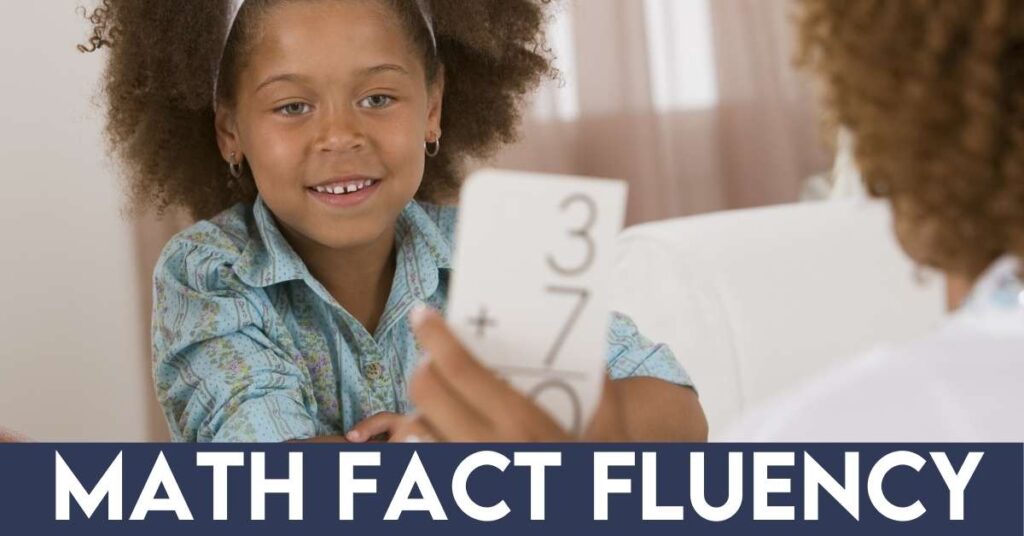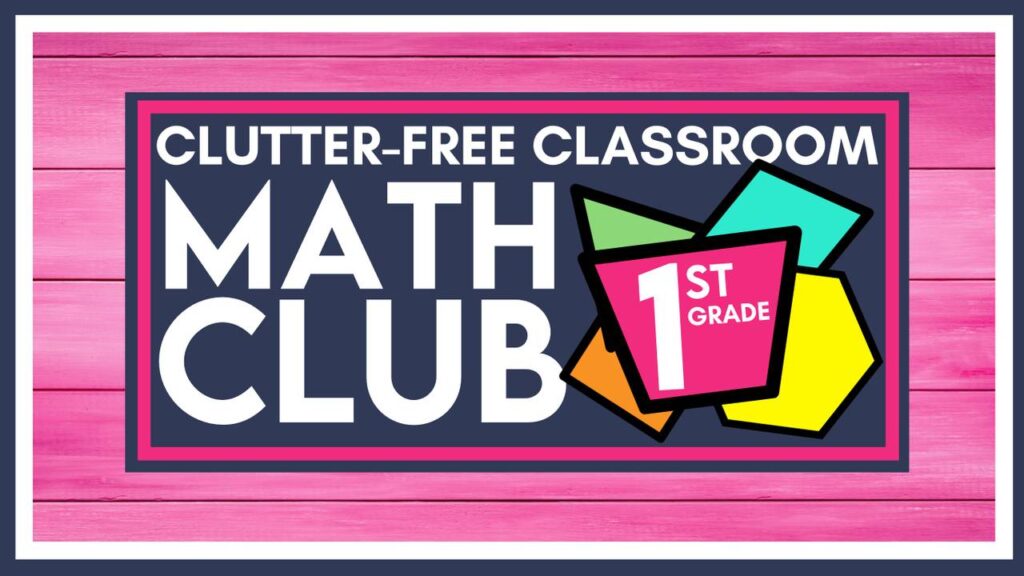There are so many common misconceptions about math fact fluency: What it is, if it’s really that important for elementary students, the best practices for how to teach it, how to properly assess it, and more. These fact fluency misunderstandings lead to a heavy focus on math fact automaticity and timed basic math fact tests (which are sometimes called mad minutes). It’s important we clear up these misconceptions surrounding math fact fluency because of how incredibly important it is in students’ elementary math education– it being one of the biggest indicators to a child’s future success in math classes.

What is Math Fact Fluency?
Math fact fluency is the ability to quickly recall addition, subtraction, multiplication, and division math facts through conceptual learning, fact strategies, and memorization. The four key components to determine mastery are 1) flexibility, 2) appropriate strategy use, 3) efficiency, and 4) accuracy.
When students achieve automaticity of their facts, a common benchmark is that they can recall them in two seconds or less (30 problems in 60 seconds). This skill is essential for students to master and tremendously impacts their future in mathematics. However, it is important to note that students naturally progress at their own rate.
As teachers, we need to provide a strong foundation for students (conceptual learning and strategies) followed by daily opportunities to practice (memorization) in fun and engaging ways.
Math Fact Fluency vs. Math Fact Automaticity
Often math fact fluency and math fact automaticity are used interchangeably; however, they are not synonyms. Fluency in math is the ability to flexibly apply strategies in an efficient and accurate way. On the other hand, automaticity in math, is being able to provide an automatic response.
When a student is fluent, they are automatic. When a student is automatic, they are not necessarily fluent. Both math fact fluency and math fact automaticity are very important for students’ future success in their math education.

Why is Math Fact Fluency Important?
Math fluency is important because it…
- contributes to students’ ability to solve more difficult problems quicker and more accurately.
- leads to success in students’ future mathematics courses and careers.
- builds confidence in students’ math ability.
Common Misconceptions about Math Fact Fluency
1. The best way to assess math fact fluency is through timed tests (e.g. mad minutes).
- Timed tests give limited information about what strategies the student used.
- They also do not give information on how flexibly the student used their strategies.
- It sends the wrong message to your students. Fast is not always best. It is important to celebrate strategies rather than speed.
- Research shows that timed tests can actually have a negative impact on students and their progress towards being fluent in math facts.
- Try math running records or math interviews instead! Both of these offer you the benefit of seeing students’ thinking in real time and provide very valuable information that you would not be able to access otherwise.
2. The best way to improve fact fluency is through drilling facts.
- Never use fact drills unless the student has developed a strong understanding of the concept and efficient strategies for the facts being practiced.
- Math games are very effective tools in helping students master facts in a fun and engaging way.
3. Fact fluency is all about memorizing facts.
- Math fact fluency is about understanding concepts and applying strategies. Math fact automaticity will come after a student masters those two pieces.

What is the Scope and Sequence of Teaching Math Fact Fluency?
Here are the three stages for how to teach math facts:
1. Conceptual Learning Conceptual Learning
- Teach the meaning of the operations so students truly understand them.
- Use and give students the opportunity to use lots of manipulatives and models for hands on learning.
2. Fact Strategies
- Explicitly teach strategies (e.g. counting on and doubles).
- Provide lots of opportunities to practice and apply these strategies.
- Emphasize relationships and connections between operations.
- Use and give students the opportunity to use lots of manipulatives and models.
- Require students to explain what strategies they used and justify their response.
3. Memorization of Basic Math Facts
- Provide varied and daily opportunities to practice.
- Students should be able to recall a fact within 2 seconds.
- Practice facts using games. Keep it fun!
- Differentiate practice.

What does the Progression of Math Fact Fluency Look Like across Grade Levels?
The building blocks of addition fluency and subtraction fluency begin in kindergarten and continue through fourth grade. Multiplication fluency and division fluency, on the other hand, begin in third grade and continue through fifth grade. Read below to see the math fact fluency standards included in the Common Core State Standards.
Kindergarten
- Fluently add and subtract within 5.
First Grade
- Add and subtract within 20, demonstrating fluency for addition and subtraction within 10. Use strategies such as counting on; making ten (e.g., 8 + 6 = 8 + 2 + 4 = 10 + 4 = 14); decomposing a number leading to a ten (e.g., 13 – 4 = 13 – 3 – 1 = 10 – 1 = 9); using the relationship between addition and subtraction (e.g., knowing that 8 + 4 = 12, one knows 12 – 8 = 4); and creating equivalent but easier or known sums (e.g., adding 6 + 7 by creating the known equivalent 6 + 6 + 1 = 12 + 1 = 13).
Second Grade
- Fluently add and subtract within 20 using mental strategies. By end of Grade 2, know from memory all sums of two one-digit numbers.
Third Grade
- Fluently add and subtract within 1000 using strategies and algorithms based on place value, properties of operations, and/or the relationship between addition and subtraction.
- Fluently multiply and divide within 100, using strategies such as the relationship between multiplication and division (e.g., knowing that 8 × 5 = 40, one knows 40 ÷ 5 = 8) or properties of operations. By the end of Grade 3, know from memory all products of two one-digit numbers.
Fourth Grade
- Fluently add and subtract multi-digit whole numbers using the standard algorithm.
Fifth Grade
- Fluently multiply multi-digit whole numbers using the standard algorithm.

How do I Fit Daily Math Fact Fluency into my Schedule?
The Math Workshop framework is a great way to implement daily math fact practice in your math block. One of the four centers within this structure is dedicated to math fact fluency practice, where students practice their basic math facts in a variety of ways. This system ensures that your students are getting the daily practice they need to become fluent and automatic with their math facts.
What are Ways I Can Help my Students Practice their Basic Math Facts?
Here are 12 ways to help your students practice their basic math facts:
- Send home information and resources to families about math fact fluency.
- Send home math games for students to play with their families for homework.
- Play math games in class.
- Commit to daily practice.
- Listen to and sing songs.
- Use a math fact fluency app.
- Utilize a website-based game.
- Track student progress in your notes and on a bulletin board.
- Invite students to track their own progress.
- Play Xtra Math.
- Celebrate strategies and successes during whole group, small group, and one-on-one lessons.
- Model and instill a growth mindset and positive attitude toward math facts.
How do I Assess Math Fluency?
When getting the full picture of a student’s mastery of basic math facts using both informal and formal math fact fluency assessments, it is important to consider four components: 1) flexibility, 2) appropriate strategy use, 3) efficiency, and 4) accuracy. Data should also include which facts students know from memory. Below is a list of tools commonly used to assess fact fluency.
- math running records
- math interviews
- observation during games
- observation during whole group discussions
- oral or written explanations of what strategy was chosen and why
- reflections in math journals
Math Resources for 1st-5th Grade Teachers
If you need printable and digital math resources for your classroom, then check out my time and money-saving math collections below!
Free Elementary Math Resources
We would love for you to try these elementary math resources with your students. It offers them opportunities to practice grade level concepts and skills (including math fact fluency) in fun and engaging ways. You can download math worksheets specific to your grade level in our free printable math resources bundle using this link: free printable math activities for elementary teachers.
Check out my Math Workshop with Guided Math Course (coming soon), Elementary Math Resource Collection, and the grade level math resources below!
- 1st Grade Math Resources
- 2nd Grade Math Resources
- 3rd Grade Math Resources
- 4th Grade Math Resources
- 5th Grade Math Resources












